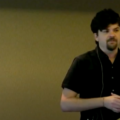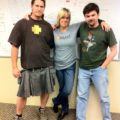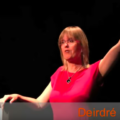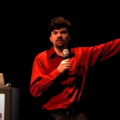Photos from last night’s Illumos meetup – a reunion of many of the old Sun gang.
Yes, video follows!
Category Archives: what I do
New Videos: The Gregg Performance Series
Working for Joyent, I continue to create lots of technical video (~32 hours of edited material to date). Most recent examples, here, are the start of a series I’m doing with Brendan Gregg (author of the DTrace book). In the course of his research to make these videos, Brendan even made some surprising discoveries about tools that everyone thought they knew all about.
Above: Brendan Gregg discusses vmstat, a performance tool used in Solaris-based operating systems, including Solaris 10, SmartOS, IllumOS, that shows the health of the entire system. Part 2 covers all the fields in detail. Part 3 talks about how vmstat works in Joyent’s SmartOS.
^ Brendan talks about the 1, 5 and 15 minute load averages as reported by tools such as uptime and prstat, and then explains in details how they work on Solaris-based Operating Systems including SmartOS, and reveals why they aren’t really 1, 5 and 15 minute averages.
Below: Brendan discusses the key fields of mpstat, another performance tool used in Solaris-based operating systems, including Solaris 10, SmartOS, Illumos, to shows the health of the CPUs on multi-processor systems. Part 2 covers all the fields in detail. Part 3 is a deeper dive into the fields using other tools.
illumos in the Cloud: What is Joyent Up to?
For years – decades, even – Sun Microsystems held some of the world’s greatest engineering talent fast in its cozy embrace. Then, as so often happens, acquisition unleashed a storm of change. A year later, a good deal of Sun’s top talent has moved on, including some well-known names from Solaris engineering. I’m sure this tech diaspora will benefit the industry as a whole, as Sun talent spreads far and wide.
For three years at Sun, I worked closely with top Solaris engineers. Many became friends, so I have kept in touch with those who left, and kept an eye on where they went. A number of the best and brightest settled at a cloud computing company out of San Francisco, called Joyent.
Bryan Cantrill, Jerry Jelinek, Brendan Gregg (with whom I worked very closely on the DTrace book), and several other members of Sun’s FISHworks team made the move to Joyent in late 2010. In addition, Joyent had brought on Ryan Dahl (the creator of Node.js, a hot new technology the world was beginning to hear about), Isaac Schlueter and more recently, Tom Hughes-Croucher (author of the upcoming Node.js book for O’Reilly). Putting all these elements together, it was clear that Joyent must be up to something very interesting; I had to become a Joyeur myself to find out exactly what was going on in the company!
We should first spend a few words to answer the question: What exactly is cloud computing? As Steve Gillmor said when asked at the O’Reilly Web 2.0 conference in 2008: to developers, cloud computing means being able to implement ideas at a very early stage, without having to concern themselves about future scaling up. This applies to start-ups and enterprises as well – companies too want a place to implement and deploy their applications or games quickly and flexibly with confidence they can scale rapidly if needed.
A good cloud hosting company provides the just-right amount of computing infrastructure, exactly when you need it. This includes “bursting” CPU capacity, so that your Facebook game doesn’t fall over when it suddenly goes viral, making you a victim of your own success. A good cloud hosting company has monitoring tools that can tell the difference between a short-term surge in traffic and a longer-term need to scale up capacity. Launched in early 2004 as one of the early pioneers of cloud computing, Joyent was the platform of choice for many popular web startups, including Twitter, WordPress and more. Over time, Joyent’s public cloud service became hugely popular with casual/social game studios, retail and ecommerce companies and many social networking applications. While the public face of Joyent has been a cloud computing service much like Amazon’s (but a lot faster), at heart Joyent is a software company.
I was already familiar with Joyent as one of the most innovative users of OpenSolaris: Ben Rockwood was a frequent conference speaker on OpenSolaris and related topics, and was active in the OpenSolaris community. Joyent was also one of the biggest contributors to OpenSolaris patches and is now a supporter of Illumos.
Based on Illumos, Joyent has created its own operating system, SmartOS, optimized for cloud computing. Why make a cloud kernel based on Illumos? From the cloud operator’s perspective, the advantages are obvious:
Maximize resource usage
- Illumos virtualization (zones and Crossbow network virtualization) lets a cloud hosting provider put more customers on the physical server (each in their own SmartMachine), while still giving all of them phenomenal performance. Joyent’s servers typically run at 70% CPU capacity, against an industry standard of around 30%.
- Creation and startup of additional zones – in other words, adding new paying customers – is nearly instantaneous.
- 100% of RAM is allocated to SmartMachines or repurposed for SmartCache as an ARC-cache layer between application and disk.
Maximize performance
- No hardware emulation means the machine runs much faster; SmartOS is the hypervisor.
- In cloud computing, latency is everything. ZFS with ARC dramatically improves disk performance, reducing a major source of slowdowns.
- 3X more transactions per second compared to Amazon EC2 of similar size and cost.
Know what’s going on
- Users of Solaris, Illumos, Mac OS X and FreeBSD know that DTrace gives you an unprecedented view throughout the software stack. But all that power comes at a price: using DTrace effectively requires expertise. The Joyent team is now harnessing the power of DTrace in a more user-friendly form with cloud analytics, which will be available to Joyent customers via a GUI and an API.
Companies who want to take advantage of the benefits of the cloud – variable costs, flexible resource usage, and affordability – are choosing Joyent for the efficiency it offers compared to legacy cloud systems. Thank you, Illumos, for giving us much better utilization and faster performance, and hence lower costs to customers.
The power of SmartOS is now available to another kind of Joyent customer: the Service Providers (telcos, ISPs, datacenter operators) who are using Joyent’s cloud software to deliver cloud services to their customers. With the cloud market expected to grow from 30-55% in coming years, it’s no wonder that so many existing providers want to get into the cloud business too. And Joyent is making this very, very easy to do.
Led by VP of Engineering Bryan Cantrill, Joyent’s very talented engineering team has rolled up years of cloud computing experience into a powerful yet easy to use software package, SmartDataCenter 6. This is the fruit of a major engineering effort around multi-tenancy operation in the cloud, including enhancements to OS-level virtualization, DTrace and ZFS. These technologies – powerful and revolutionary as they are – are only the foundation of a cloud operating system. Using Node.js – a Joyent framework for high-throughput, evented-oriented systems – Joyent has built orchestration and management software that turns these foundational OS technologies into a revolutionary cloud offering.
I’m excited to be here at Joyent, working with amazing people on wonderful things. If you’re a current Joyent customer, or a prospect interested in learning more, please drop me a line or go to Joyent.com or JoyentCloud.com to learn more. I’mDeirdre@joyent.com.
originally published in Sun System News
node.js Community Event: Rough Cut Videos
Joyent hosted a node.js community event at our San Francisco offices the other evening, in which Ryan Dahl announced a new version of node.js, and Brendan Gregg showed some amazing stuff you can do with Joyent Cloud Analytics on your no.de hosted site to understand what’s going on in your node.js app.
For more details on cloud analytics, see Dave’s and Robert’s blogs, and two more hours of video with Bryan and Brendan demoing.
Technical difficulties with UStream meant I didn’t have a stream recorded to their servers that night, technical difficulties with everything else meant I couldn’t get these rough cuts hosted anywhere til now. This is exactly what you would have seen on the stream (and more), including the bad camera angle which was forced by… oh never mind. A better view of cloud analytics will be forthcoming.
(NB: These videos disappeared from Joyent some time ago. Sorry.)
Joyent End User Tutorial Videos
Wondering what I’m up to in my new job? As mentioned, I work for Joyent, which does cloud computing. In addition to and as part of my job as Director of Technical Training, I’m doing a lot of video (well, what did you expect?) including live streaming events like a talk by Bryan Cantrill and Brendan Gregg on Cloud Analytics.
I’m also helping to produce videos to help customers of Joyent’s public cloud, below are a few examples.
For my Solaris buddies, there’s a special offer still in effect: you can try out a 1GB SmartMachine for just $45 per month (that’s $80 off the regular price). This monthly price is good for as long as you keep your SmartMachine.
Introduction to Joyent Virtualmin and Webmin
Setting Up a New Domain on Your Joyent SmartMachine
Recovering a Password for Your SmartMachine
Accessing Your SmartMachine from Windows Using Putty
Backing Up MySQL with Webmin
I only do final edits on these, the scripting and production are by Joyent‘s Jasun Wurster.






